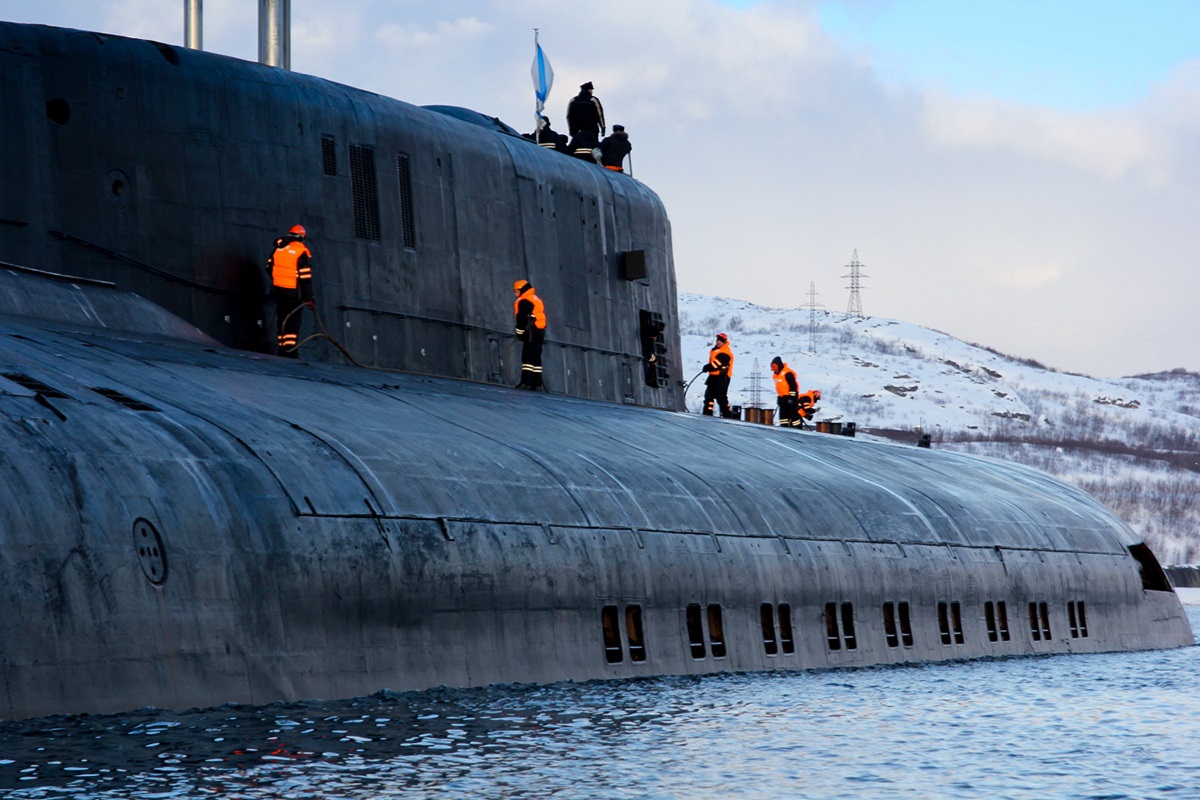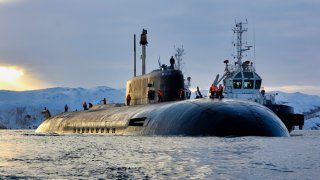A 'Torpedo Malfunction' Sank a Russian Oscar-Class 'Carrier-Killer' Submarine
On August 12, 2000, two explosions shook the Barents Sea, marking the beginning of a tragic disaster for the Russian submarine Kursk. The Oscar-class submarine, designed to carry cruise missiles, suffered a catastrophic explosion during a naval exercise.
What You Need to Know: On August 12, 2000, two explosions shook the Barents Sea, marking the beginning of a tragic disaster for the Russian submarine Kursk. The Oscar-class submarine, designed to carry cruise missiles, suffered a catastrophic explosion during a naval exercise.

-Delays in the rescue mission, exacerbated by Russia’s refusal to accept international assistance, doomed the 118 crew members, including 23 survivors trapped in the submarine’s rear compartment. Investigations revealed the initial explosion was caused by leaking fuel from a torpedo.
-The incident highlighted critical failures in training, equipment maintenance, and Russia’s handling of the rescue.
Kursk Disaster: The Tragic Tale of a Sunken Russian Submarine
On August 12, 2000, the waters of the Barents Sea were shaken by two explosions. Sailors aboard the Russian submarine Karelia detected the explosions but presumed they were related to a major naval exercise of which the Karelia was a part.
Tragically, however, the detonations had occurred aboard the Oscar-class submarine Kursk, and they spelled disaster for that submarine and its crew.
Kursk: What happened?
The Kursk was a cruise missile submarine launched in 1994, one of the first ships built by the Russian Federation after the collapse of the Soviet Union.
The Oscar class was designed to rain cruise missiles down on a U.S. carrier strike group and was one of the largest submarines ever, behind only Soviet Typhoon-class and U.S. Ohio-class ballistic missile submarines.
In August of 2000, the Kursk was participating in the Summer-X exercise, the first major fleet maneuver of the Russian Navy. As part of the test, the vessel was to launch a pair of training torpedoes at a Russian cruiser. In addition to these dummy warheads, the Kursk carried a full complement of live ordnance, from torpedoes to cruise missiles.
It was one of the few Russian ships authorized to do so. A few hours after requesting permission to begin the test, the first explosion measuring 1.5 on the Richter scale was detected by Russian naval assets, as well as by a Norwegian seismic monitoring station. Just over two minutes later, a second, much greater explosion was detected — 4.2 on the Richter scale.
The Rescue Effort
The Kursk was supposed to check in that afternoon following the completion of the test, but senior officers were not overly concerned at first. They suspected a failure of the communication equipment, a common problem aboard the sub.

It wasn’t until nearly five hours later, and after repeated failures to contact the sub, that a search and rescue effort was ordered.
Two Russian mini-submersibles, the AS-32 and AS-34, headed up the rescue effort.
By the evening of Sunday, August 13, they had located the stricken Kursk on the seabed, 354 feet below the surface. The bow was completely destroyed, and the first four compartments were flooded.
The submersible made repeated attempts to gain a seal over the rear escape hatch but was ultimately unsuccessful. In the following days, the rescue effort was hampered by increasingly strong winds and heavy seas. Additional submersibles were brought in, but they too failed to successfully seal against the escape hatch. Diving bells lowered by ships on the surface encountered the same problem.
The U.S. and other Western nations were aware of the accident the day that it happened, and a coalition including the UK, France, Germany, Norway, and Israel offered assistance to the Russian Navy.
Russia turned down this assistance as Moscow sought to downplay and obfuscate the nature of the disaster, both from the world at large and from its own citizens. Finally, five days after the accident and in the face of considerable media and public backlash, Russian President Vladimir Putin accepted British and Norwegian help.
Tragic Conclusion
Initially there was a great deal of hope that some survivors had held out in the relatively undamaged rear of the submarine. As the rescue dragged on, however, hope waned. When a Norwegian dive team finally gained entry to the wreck 10 days after the accident, they only found bodies.
Once it was determined that none of the crew had survived, Russia moved to salvage the Kursk. A Dutch company was contracted to lift the submarine from its resting place on the seabed. The bow was removed before the sub was lifted, due to concerns over unexploded ordnance and structural instability. It was eventually destroyed where it lay on the seafloor.
Upon refloating the Kursk, the full nature of the disaster was revealed. There had indeed been survivors — 23 sailors that congregated in the rearmost, ninth compartment. The nuclear reactors powering the sub had gone into emergency shutdown. This was a blessing in that they were inert and stable, but it meant all power, light, and air recycling processes were shut down.
The men in the ninth compartment managed to survive for a time using battery-powered lights and chemical oxygen scrubbers. Their fate had already been sealed, however, due to where they were and the type of boat they were on. Although 354 feet is deep, the men would have most likely been able to survive an emergency ascent. Being stuck in the icy cold of the Barents Sea, however, would have been a sure death sentence if they were not swiftly spotted and rescued. Furthermore, some personnel were too injured to clamber into the escape trunk and attempt the ascent.
Once the crew decided to stay aboard, they became victims of a quirk of the Kursk, and indeed of all Oscar-class submarines — an imperfect seal where the propeller shafts exited the hull. When stationary, water leaked in around the shafts. With the sub at rest on the seabed, water continued leaking in, driving up the pressure inside the compartment and making an emergency ascent physiologically impossible.
With the air scrubbers turned off, the survivors relied on chemical scrubbers to remove poisonous carbon dioxide. Ultimately, it appears one of these scrubbers was dropped as the crew attempted to replace a used cartridge. When it splashed into the oily water, a chemical reaction ignited a flash fire in the pressurized air that burned off all the remaining oxygen, causing the remaining survivors to asphyxiate.
Cause of the Sinking
With the sub on the surface, investigators were able to determine the cause of the mishap.
The Kursk was using torpedoes propelled by high-test peroxide (HTP). This chemical compound is normally stable, but in the presence of a catalyst it becomes a highly potent oxidizer. It appears the practice torpedo in use leaked enough of this fuel when it was loaded into the tube to cause the first explosion.
The forces of the initial explosion tore through the torpedo compartment, burning at temperatures estimated at nearly 5,000 degrees Fahrenheit. Such monumental pressure and temperature caused at least seven other torpedoes to detonate, producing the second explosion. Water swiftly rushed into the ruined bow of the submarine, tearing through bulkheads until it was stopped by reinforced bulkhead number five, which protected the nuclear reactors.
Aftermath/Coverup
The Russian state sought to spin and cover up the botched rescue that might have saved the trapped sailors. Attempts were made to deflect blame by stating the mishap was caused by a collision with a NATO submarine that was monitoring the exercise. It was noted that the sub’s rescue beacon, designed to automatically float to the surface in the event of disaster to aid in location, had been disabled prior to a deployment to the Mediterranean the year before.
Review of documentation aboard the Kursk revealed that the crew had not been adequately trained to handle HTP torpedoes, or indeed the specific type of torpedo loaded. A secret report found “stunning breaches of discipline, shoddy, obsolete and poorly maintained equipment" and "negligence, incompetence, and mismanagement." It went on to criticize delays in initiating the rescue operation.
Ultimately, apart from some shake-ups in Putin’s cabinet, few were held to account for the tragic loss of the Kursk and all 118 sailors aboard.
About the Author: Maya Carlin
Maya Carlin is an analyst with the Center for Security Policy and a former Anna Sobol Levy Fellow at IDC Herzliya in Israel. She has by-lines in many publications, including The National Interest, Jerusalem Post, and Times of Israel. You can follow her on Twitter: @MayaCarlin.
Image Credit: Creative Commons.


